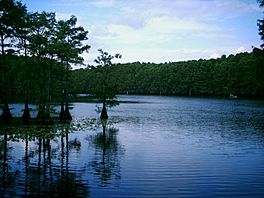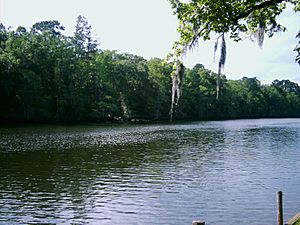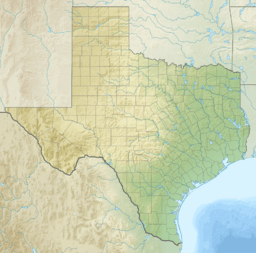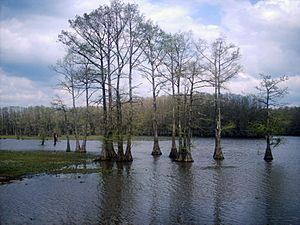Caddo Lake facts for kids
Quick facts for kids Caddo Lake |
|
|---|---|

Viewed from a point near Uncertain
|
|
| Location | Texas, Louisiana |
| Coordinates | 32°43′N 94°01′W / 32.71°N 94.01°W |
| Basin countries | United States |
| Surface area | 25,400 acres (10,300 ha) |
| Surface elevation | 161 ft (49 m) |
| Islands | Tar Island |
| Designated: | 23 October 1993 |
| Reference #: | 633 |
Caddo Lake (French: Lac Caddo) is a large lake and bayou (a slow-moving swampy area). It covers about 25,400 acres. This special place sits right on the border between Texas and Louisiana.
The lake gets its name from the Caddo people. They were Native Americans who lived in this area for a very long time. Caddo Lake is super important. It's an internationally protected wetland. This means it's recognized for its unique nature under the Ramsar Convention. It also has one of the biggest flooded cypress forests in the United States.
Caddo Lake is one of the few natural lakes in Texas. It's also the second-largest natural lake in the South. However, people changed it a bit. A dam was added in the 1900s.
Contents
How Caddo Lake Was Formed
The Caddo people have a cool legend about the lake. They say it was formed by huge 1811–12 New Madrid earthquakes. There might be some truth to this story. Another lake, Reelfoot Lake in Tennessee, was indeed formed by that same earthquake.
Most scientists think the lake formed because of something called the "Great Raft." This was a giant log jam on the Red River in Louisiana. It was about 100 miles (160 km) long! This huge log jam likely caused the water to back up. It flooded the low-lying area where the lake is now. This could have happened slowly or very quickly.
History of Caddo Lake

Native Americans used Caddo Lake for thousands of years. But big changes came in the 1800s. This was when steamboats became popular. The United States also gained control of Louisiana and Texas.
Cities like Port Caddo and Jefferson in Texas grew. Mooringsport in Louisiana also became busy. They all had thriving riverboat ports on the lake. Steamboats used the lake to move goods and people.
Over time, people started removing the log jams. Captain Henry Miller Shreve and the Army Corps of Engineers worked on this. As the log jams were cleared, the lake's water level dropped. It fell over 10 feet! This hurt the riverboat industry in East Texas.
Later, oil was found under Caddo Lake. Oil derricks (towers for drilling) appeared all over the lake. This happened around the early 1900s. The oil industry caused more damage to the lake's delicate ecosystem. Eventually, the oil companies moved to other places.
In 1934, Texas tried to protect parts of Caddo Lake. They created a state park. The WPA helped build it. In the mid-1900s, a plant called the Longhorn Army Ammunition Plant was built nearby. This plant caused a lot of pollution in the surrounding wetlands. It closed in the 1990s. Now, most of that area is a federal wildlife refuge.
Wildlife of Caddo Lake
Caddo Lake is home to many amazing animals! You can find owls, snakes, and frogs here. There are also waterfowl (birds that live on water). Look out for bobcats, river otters, and beavers. Eagles soar above, and alligators swim in the water.
Protecting Caddo Lake
Efforts to protect Caddo Lake really picked up in 1993. The Nature Conservancy bought 7,000 acres (28 km²) of land. This land was combined with the 483-acre (2 km²) Caddo Lake State Park. Together, they became the Caddo Lake State Park and Wildlife Management Area.
Thanks to groups like the Caddo Lake Institute, Caddo Lake got special protection. In October 1993, it became one of only thirteen areas in the United States protected by the Ramsar Convention. This means it's recognized as a wetland of international importance.
By 2003, Caddo Lake was home to many different living things. It had 189 species of trees and shrubs. There were 75 kinds of grasses and 42 woody vines. The lake also had 216 kinds of birds. You could find 90 types of fish and reptiles. Plus, there were 47 different mammals.
One special plant is the Crataegus opaca, or mayhaw. Its fruit is used to make delicious jelly! Sadly, 44 of Caddo's native species were either endangered, threatened, or rare. This means they are at risk of disappearing.
From 2001 to 2003, people living near Caddo Lake fought a legal battle. It was with the City of Marshall, Texas over water rights. Famous musician Don Henley (from The Eagles) also spoke out to help protect Caddo Lake.
Current Challenges for Caddo Lake
Caddo Lake is currently facing a big problem. A fast-spreading plant called Salvinia molesta is taking over. It's also known as Giant Salvinia. This plant looks like Velcro and grows very quickly. It can double in size every two to four days! When it covers the surface, it blocks sunlight. This can kill other life below the water.
This plant was accidentally brought to the lake by boaters. Most of it is currently on the Louisiana side. Officials there have been busy recovering from hurricanes.
People are trying different ways to remove the weed. They've used special beetles that eat the plant. But these beetles can't survive the cold Texas winters. Now, they are also using special chemicals called herbicides. The Texas Water Resource Institute has a project. It's looking at many ways to get rid of the Giant Salvinia.
Texas Bigfoot Sightings
Since 1965, there have been many stories about Bigfoot at Caddo Lake. The North American Wood Ape Conservancy (NAWAC) says there have been hundreds of alleged sightings. The Travel Channel even made a documentary about it in 2006!
Cities and Towns on Caddo Lake








